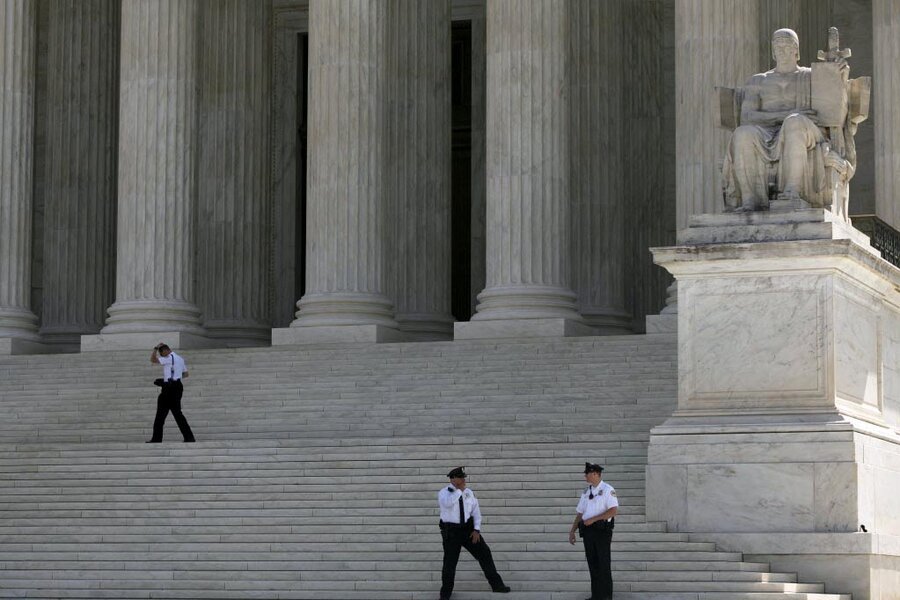Supreme Court declines potentially key Second Amendment case
Loading...
| Washington
The United States Supreme Court declined on Monday to take up a potentially important Second Amendment challenge to a San Francisco ordinance requiring handguns to be stored at home in a lock box or with a trigger lock.
The action lets stand a decision by a federal appeals panel that upheld the San Francisco ordinance last year. The appeals court said any burden imposed by the lock box and trigger lock requirements was not significant enough to violate the Second Amendment.
Apart from the lock requirements, the regulation allows gun owners to keep firearms unlocked in the home as long as the firearm is being carried by the owner.
Those challenging the law had argued that the appeals court panel failed to properly apply a 2008 high court precedent, District of Columbia v. Heller, in which the Supreme Court declared Americans possess a fundamental right to keep and possess handguns at home for self-defense.
In reaching that 2008 decision, the justices invalidated an ordinance in Washington that banned all handguns and required trigger locks on any other firearms in a home in the city.
The Supreme Court struck down the ban and the trigger lock requirement as inconsistent with a right to possess firearms for self defense in the home. The high court said that the Second Amendment guarantees more than just access to a firearm, but the ability to use it quickly, if needed, for self defense.
Supporters of San Francisco’s gun law said it would help save lives by preventing suicides and accidental shootings by children who gain access to a loaded gun.
Opponents of the San Francisco law said the Supreme Court’s 2008 decision should apply in San Francisco.
The court offered no explanation on Monday for its decision not to hear the San Francisco case.
In a dissent, Justices Clarence Thomas and Antonin Scalia said the appeals court’s ruling in the San Francisco case was “in serious tension” with the Supreme Court’s 2008 precedent and that the Supreme Court should hear the case.
“San Francisco’s law allows residents to use their handguns for the purpose of self-defense, but it prohibits them from keeping those handguns operable for the purpose of immediate self-defense when not carried on the person,” Justice Thomas wrote in a six-page dissent.
“The law thus burdens their right to self-defense at the times they are most vulnerable – when they are sleeping, bathing, changing clothes, or otherwise indisposed,” he said. “There is consequently no question that San Francisco’s law burdens the core of the Second Amendment right.”
In 2007, San Francisco enacted the ordinance which bars any person from keeping a handgun in a home unless the gun is stored in a locked container, disabled with a trigger lock, or is in the direct possession of a person over age 18.
Violations are punishable by six months in jail and a $1,000 fine.
The measure was passed in an effort to enhance public safety by preventing handgun injuries, both intentional and accidental.
The city found that lock boxes and trigger guards did not substantially reduce the ability of a gun owner to use their firearm for self defense in the home.
Critics of the gun storage ordinance said it made it illegal for a law-abiding homeowner to keep a loaded handgun on a nightstand or in a drawer in his or her bedroom as protection against a night-time intruder.
They said the lock box requirement would mean that the homeowner would have to turn on a light, fumble to find reading glasses, and seek to open the lock box – all after an intruder had presumably already entered the home.
Six San Francisco residents, the National Rifle Association, and the San Francisco Veteran Police Officers Association filed suit in 2009.
A federal judge upheld the city’s regulation, ruling that any burden on the plaintiffs’ Second Amendment rights was not significant enough to entitle them to court-ordered relief.
A homeowner could quickly gain access to a weapon from a lock box or disable a trigger guard and still use the firearm for self defense, the judge said.
A three-judge panel of the San Francisco-based Ninth US Circuit Court of Appeals affirmed the decision.
In his dissent, Thomas said the Supreme Court should have agreed to hear the case and apply a more rigorous test of the city’s gun ordinance. “When a law burdens a constitutionally protected right, we have generally required a higher showing than the court of appeals demanded here,” he said.
“In an emergency situation, the delay imposed by this law could prevent San Francisco residents from using their handguns for the lawful purpose of self-defense,” Thomas said. “And that delay could easily be the difference between life and death.”
The case was Espanola Jackson v. City and County of San Francisco (14-704).







